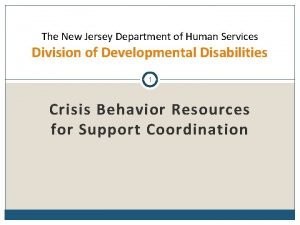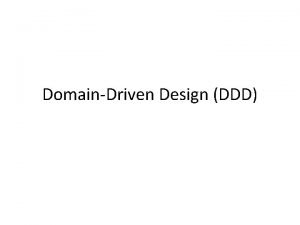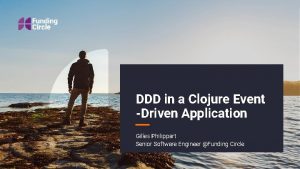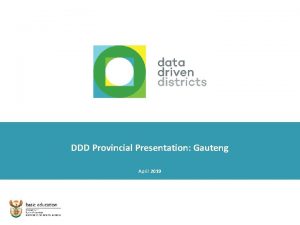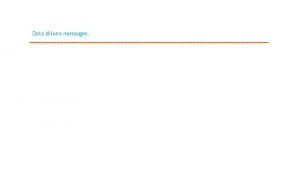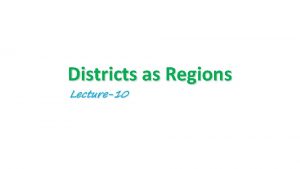Data Driven Districts DDD Pockets of Success April












- Slides: 12

Data Driven Districts (DDD) Pockets of Success April 2016

DDD Project Background DDD Aim The Data Driven Districts (DDD) project aims to improve learner outcomes by supporting the way SA-SAMS data is collected and used by officials in the education system to support schools and educators more effectively. How it impacts education Current project reach The DDD project makes key SA-SAMS data available to officials via the online DDD Dashboard. The Dashboard displays SA-SAMS data on attendance, achievement, curriculum coverage and promotion from a school level right up to a national view. This empowers officials to make data driven decisions. Explore the illustrative Dashboard today www. eddashboard. co. za

Principal Takes a Hands-On Approach Mike Mashishi Principal – B. B. Matlaila Primary School Principal Mashishi was not familiar with the Dashboard until he became principal at B. B. Matlaila in July 2015. He quickly familiarised himself with the tool and identified two areas of concern on the Dashboard and took a hands-on approach to resolving the issue. Navigating the Dashboard Principal Mashishi says “it is easy, if you have been to the workshop then it is very clear what is expected. There’s nothing difficult because nothing is hidden. It’s just a question of knowing what you want”. He goes on to say that “it’s a helpful tool, I no longer look through stacks of books to understand what is happening in the classrooms”. “The Dashboard offers me a comprehensive view of my school”. “I log onto the Dashboard and if I see red, I know there is a problem. ” Dashboard driven intervention Principal Mashishi noticed that results for Technology in Grade 7 were not meeting his expectations. “For a more practical subject such as Technology I expect 70% and above”. He questioned why learners were underperforming in this particular subject and upon further investigation, he realised that some educators were not aware of the policy requirements for Technology and other subjects. Principal Mashishi met with the heads of department to interpret the subject related policies to ensure that all curriculum requirements were met for each subject. Hands on approach Principal Mashishi took it upon himself to teach Grade 7 Technology and saw a dramatic increase in the School Based Assessment (SBA) marks in the following term. Technology SBA Mark Term 3 2015 Term 4 2015 32% 72%

Data Driven District Director Mohotsi Mothebe, District Director Xhariep is semi-rural and the distances between schools can exceed 200 km. Mr Mothebe uses the DDD Dashboard to monitor the schools in his district and operates the online tool with ease. What Interventions have been initiated due to the Dashboard? “One interesting outcome was when I tried to resolve a poor attendance issue. ” Mr Mothebe identified a teacher with 56% attendance for 2015. Upon further investigation he established a long standing feud between the deputy principal and the principal which resulted in the deputy being absent for extended periods. “Without the Dashboard I would not have realised that this feud between the principal and deputy principal was leading to lost teaching time and negatively impacting the students. ” “Things have improved significantly since I brought the two individuals together and dealt with the conflict. How does the Dashboard assist you in your duties? “The Dashboard helps me to identify keys issues before visiting schools. I have a bird’s eye view of which schools to visit, what to investigate and who to investigate before leaving my office. ” “This tool is the most effective management tool I have used in the last 37 years I have been in education. ” Although there are existing processes in place, they take a long time to get back to you, but with the dashboard I can view the data immediately and make a decision on the spot. “ “The Dashboard is also very handy because the data is disaggregated by circuits, the third layer of management. This helps me to immediately identify which circuits are not performing. I then go deeper to confirm if the data reflects reality and it does. I then investigate additional issues like complaints, trends and other dimensions to confirm the performance shown on the dashboard. I have often used the data to identify poor learner or educator attendance. Then from the school visit I can then decide if I must call the learners or educators for a stern motivational talk. ”

District Director Driving Data Usage Mamsi Makubela District Director, Johannesburg South Mamsi has been Johannesburg South’s district director for three and a half years. She believes the DDD Project aligns well with government priorities to improve learner performance through a data driven education system. Establishing Data Trends “In previous years we have not been able to quantify learner performance and relate it to teacher performance. ” The Dashboard assists by tracking key metrics such as attendance and curriculum coverage. “When we know how learners understand their work through data, then we know what interventions to make. ” “The Dashboard is a reliable tool to track what is happening in schools, I use the Dashboard to establish trends and implement system wide interventions. “ Becoming Data Driven “The district didn’t have any prior knowledge or interactions with the DDD project so we sought to introduce changes slowly. ” “We were doing well academically but I said unless we become data driven we will never compete with the best of the best. ” Mamsi is a strong advocate for the DDD project and is actively driving her district towards efficient and effective use of data. Creating Communities of Practice In order to establish a data driven culture, Mamsi has formed Communities of Practice (Co. P) for schools in her district. She has grouped 4 schools into each Co. P in order to share knowledge and provide support particularly during data submission periods. “The participants meet at one school where they complete their SA-SAMS data submissions in an environment where they can work together and support one another. ” Mamsi put considerable thought into which schools to group together “I know they can work together and the synergy is beautiful”.

Mamsi’s 4 Steps to Driving Data 1 Clean up SA-SAMS is at the foundation of data success. Submitting good quality data through SA-SAMS is essential to the value schools and officials will gain from the Dashboard. “An enormous effort was made to clean up the school databases to improve data quality. ” 4 Communication “The message is clear, districts that do well are data driven. ” “Change is not easy but every opportunity I have gotten I have shown the value of this tool. I’ve been driving and pushing it, bringing others who are using the Dashboard to demonstrate it’s value. ” 2 Coaching Dashboard training is an integral step in the process of achieving data success throughout the district. “The visual appeal of the Dashboard certainly helps and the training evokes interest where the emphasise is placed on the value of the tool. ” 3 Collaboration is key and Mamsi’s implementation of Co. Ps has been a fantastic strategy for implementation. Where individuals have struggled alone with submission, it is now a team effort. “Schools can support one another in various areas to ensure the DDD project progresses. ”

Mpumalanga Submission Success Hangwani Matidza Chief Education Specialist (CES) Hangwani has been identified as one of the main catalysts for the traction that the DDD Project has taken in Mpumalanga. DDD buy-in In his role as CES, Hangwani oversees the management and service provided by the Education Management Information Systems (EMIS) officers in Nelspruit, Mpumalanga. He played a crucial role in spearheading the implementation of the project, laying the groundwork for the successful roll out in the province. Following some initial resistance to the SA-SAMS usage drive, schools are now on board and acknowledge the added benefits that the Dashboard provides. Hangwani was a participant in Mpumalanga’s DDD Train-the-Trainer training. Train-the-Trainer triumph DDD conducted Train-the-Trainer training to 20 Mpumalanga district officials who are now able to train fellow district officials on how to use the Dashboard in their daily managerial activities. The immediate willingness of the district officials in becoming DDD Dashboard training facilitators indicates how Mpumalanga has driven the progress of DDD project and its sustainability in the province. Reaping the rewards Mpumalanga’s commitment and enthusiasm is evident in the impressive start they’ve made in their Term 1 submissions. In one week the number of Mpumalanga’s school submissions went from 2% to 84% of schools loaded on the Dashboard. There is currently a total of 1703 schools and 915 500 learners loaded onto the Dashboard for Mpumalanga. Within three months following their qualification as DDD Certified Trainers, the 20 district officials created over 1300 Dashboard users in Mpumalanga.

Dashboard used to inform SGB Meetings Nardus Vosser Principal, Laerskool Bysonderheid Principal Vosser makes use of the Dashboard to inform his School Governing Body (SGB) meetings and track teacher performance. Tracking teacher performance Principal Vosser makes use of the Dashboard to obtain an objective view of teacher performance. “I can look at the Dashboard and see the performance of each teacher and that can help to inform salary increases and other important decisions. ” “It’s a brilliant system, gives concrete evidence rather than a teacher self-evaluating. ” “Our focus is on supporting rather than accusing teachers of underperformance” The dashboard can also be used to set targets in order to motivate teachers and track their progress from term to term. Why do you use the Dashboard? “It’s a good instrument. I can print out reports, do some preparation and present to the SGB on areas where we have progressed or have challenges. ” “With the use of the Dashboard, the SGB can see where the challenges are which makes it easier to get them on board. “The Dashboard helps me to keep a finger on the pulse of the school and provide the necessary support. ” When do you use the Dashboard? “I make use of the Dashboard when we have meetings about certain learning areas that are having challenges, the Dashboard offers a useful overview”. “I make use of the reports such as The Principals (Dashboard) Report for a term comparison as well as the SMT report. I use the Subject Performance report when I meet with the SGB. ” “During the term I will go and see how the information has been displayed and check absenteeism. ”

Achieving Data Excellence Thato Menyatsoe Data Administrator, Dr Merry Malahlela Primary School Support Brings Success When Thato was employed by the school 5 years ago, she had no knowledge of SASAMS. She slowly built up her skills and in 2015 Thato attended a five day workshop at the Matthew Goniwe School of Leadership and Governance. This provided Thato with the confidence to hone her SASAMS skills. With the support of her principal Mr Setati and IT technician Ms Majova, Thato is now confident in her use of SA-SAMS and achieved a 100% data quality score for her Term 4 data. Daily Data Duties Thato is committed to her daily data capturing schedule to ensure that she doesn’t fall behind. “I was encouraged to capture absenteeism every single day and now it’s the first thing I do each morning. ” “I work extra hours to ensure that all my learner data is captured”. Attendance is an important metric in the Valistractor tool. Check and Correct Thato is now able to use the Valistractor to check the quality and completeness of her school’s database. “The Valistractor motivates me to do my job 100%. If my learner attendance indicator is red then I know there is something that is not right. “I can always check and correct”. “I know that I must be aligned with the Valistractor. It helps me to know that I am achieving success. ” Thato’s enthusiasm and dedication is evident in the pride she takes in completing her data capturing duties to ensure an accurate representation of the school.

Principal’s Data Driven Approach to School Management Nicholas Yende Principal at Kuzimisela Primary School, Daveyton Introduction Mr Yende started using the DDD Dashboard in 2014 and has found the tool to be very useful. The Dashboard has provided him with access to valuable information and changed the way he manages his school with an increased focus on data-driven interventions. Positive Change in Attitude At first, Principal Yende was sceptical about the project: “Let me be honest, initially I had an attitude. I questioned how it was going to work and how it would help me. ” But thanks to the training and support he received from DDD trainers and district officials, he was quickly convinced of the value the Dashboard can provide. Mr Yende explains, “At first I was not aware of the end result, now I am very thankful. ” New Approach to School Management Principal Yende makes use of the Dashboard as a way to get a view on what is happening at his school. He is able to identify where there are challenges, and strategise what interventions need to be implemented in the following term. The Dashboard enables him to have data-driven conversations with the appropriate educators about a relevant course of action. “I use the curriculum information in SMT meetings to analyse our school results. I also have one-on-one meetings with teachers whose learning areas are not preforming and come up with a strategy to improve these results. ”

Number of SA-SAMS school databases submitted per province 8000 Number of SA-SAMS school databases 7000 The number of quality SA-SAMS databases submitted to the Dashboard has increased 1257 6000 1748 5000 314 4000 1304 1284 3000 1602 1396 1515 2000 76 74 164 488 491 1223 1300 T 2 2014 Free State 1099 1042 390 164 163 491 504 1099 T 3 2014 Gauteng 1305 581 803 1159 1308 1181 1153 1309 T 4 2014 T 1 2015 T 2 2015 T 3 2015 T 4 2015 T 1 2016 Limpopo Mpumalanga 494 232 1000 71 924 0 T 4 2013 T 1 2014 North West

Any questions ? Send any questions you have to the DDD Helpdesk help@dbedashboard. co. za & Explore the illustrative Dashboard today www. eddashboard. co. za





